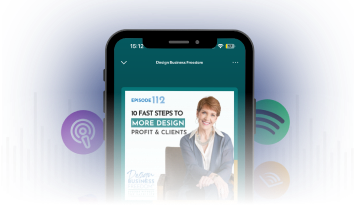5 Ways to Beat Overwhelm in Your Design Business
Running an interior design business can sometimes feel overwhelming, especially when you’re juggling multiple projects, clients, and personal commitments. Managing overwhelm in design is often about perception rather than reality. The good news is that there are practical steps you can take to alleviate or even eliminate this feeling. Here are five ways to beat overwhelm in your design business and regain control of your time and energy.
1. Send Regular Project Updates
One of the biggest sources of overwhelm for designers is the constant communication from clients—texts, calls, emails, and voicemails that interrupt your flow and disrupt your day. A simple yet effective way to manage this is by sending regular project updates. Whether weekly or bi-weekly, these updates should be short, to the point, and sent out on the same day and time consistently.
By providing clients with regular updates, you reduce their need to reach out with questions or concerns. They’ll feel informed, valued, and reassured, which cuts down on the noise and allows you to focus on your work. This practice not only reduces client-initiated interruptions but also helps you stay organized and in control of your projects, effectively managing overwhelm in design.

2. Set Clear Communication Boundaries
Many designers struggle with setting healthy boundaries around communication. Do not feel compelled to respond immediately to every ping, ding, and buzz from your devices. This constant interruption is a major contributor to managing overwhelm in design. Establish clear communication boundaries with your clients from the outset.
Implement a policy where you respond to emails, texts, and voicemails only twice a day—once in the morning and once in the late afternoon. This allows you to concentrate on your work without constant distractions. Let your clients know about this policy upfront and include it in your agreements. This not only improves your productivity but also sets expectations that protect your time and well-being.
3. Embrace Time Blocking
Time blocking is a powerful tool for managing your schedule and reducing overwhelm. Instead of reacting to tasks as they come up, plan your days and weeks in advance. Allocate specific blocks of time for different activities. Use tools including Google Calendar, which allows you to color-code your tasks and create a clear visual map of your day.
Time blocking eliminates the chaos of last-minute decisions and helps you stay focused on what’s important. By organizing your time into blocks dedicated to specific tasks—such as creative design work, client meetings, business development, and self-care—you can ensure that everything gets done without feeling rushed or overwhelmed.
4. Use a Small Task List
One common mistake that leads to overwhelm is creating massive to-do lists that are impossible to complete in a day or even a week. Limit your daily task list to what can fit on an index card or a large Post-it note (no bigger than 4×6 inches). This forces you to prioritize and focus only on the most critical tasks.
By keeping your daily task list small and manageable, you’re more likely to complete everything on it, which gives you a sense of accomplishment and reduces the perception of overwhelm. Over time, this approach helps you develop a more realistic view of what you can achieve each day.
5. Stay Present and Focused
Overwhelm often arises when we’re either dwelling on the past or worrying about the future. Stay present and focus on the here and now. Instead of thinking about everything you need to do in the future or regretting what you didn’t do in the past, concentrate on the current moment.
Break your day into smaller, manageable chunks—what will you accomplish in the next hour or by the end of the day? By staying focused on the present, you reduce anxiety and increase your productivity. This practice helps you tackle tasks one at a time, making even the busiest days feel more manageable and is a critical component of managing overwhelm in design.
Key Takeaways
Managing overwhelm in design doesn’t have to be a constant challenge in your business. By implementing regular project updates, setting clear communication boundaries, embracing time blocking, using a small task list, and staying present, you can take control of your time and reduce stress.Remember, these strategies are about working smarter, not harder, and they’ll help you create a more balanced and fulfilling work life.
When you’re ready to increase your interior design business profits, work exclusively with ideal clients, and enjoy the time and resources for your extraordinary life, explore your coaching options. We’ve got your back in the business of design and the business of home.



